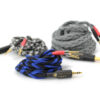Ultra-low capacitance adapter for balanced Headphone cable to balanced/unbalanced source
£40.00
In stock
Description
This is an audiophile grade, ultra-low capacitance adapter cable for use on balanced cables to plug into an alternative balanced or unbalanced (stereo) source. For example, allowing a 4-pin XLR cable to plug into a 6.35mm stereo source.
This is a 4 wire adaptor designed to adapt headphone cables to fit a different connection. Please to not try to plug a single ended ( not balanced ) cable into a balanced amp as it may damage some amplifiers. Going from one balanced connection to another is fine, plugging a balanced headphone cable into a single ended source is fine but plugging a single ended headphone cable such as one with a 3.5mm jack into an adapter to use it with a balanced amplifier is not recommended – you will get no real advantage doing that and it may damage some amps. If you are unsure pop us an email [email protected]
If you need a fully balanced 6 wire cable for linking a balanced player to a balanced amp, we have those listed separately – these adapters are not designed to do that as they don’t have a separate ground wire
What material is the wire made of and why?
Our wire is made from OFC Litz copper. Each core is made up of 84 individually insulated strands of 0.071mm diameter copper. They are held together by natural silk fibres and covered with an oversized nylon outer cover to give a decent air gap between cores.
Why OFC copper rather than OCC or Silver.
For the same cross-sectional area, silver is about 7% more conductive than copper – but if you double the cross sectional area, you can roughly halve the impedance. It is therefore much cheaper to use more copper to get the same improvements. By using a thicker copper wire, we can get better impedance figures than a thinner silver cable. OCC has some definite advantages, being more flexible, but as our strands are so thin the wire is very flexible already.
What is the advantage of Litz vs stranded copper in terms of skin effect?
With a standard stranded copper wire, as charge can move from one strand to another, they act as one thick solid conductor.
Skin effect pushes higher frequencies out to the edges of the wire, meaning they are travelling through less of the area of the cable. The skin depth reduces as the frequency increases, so on thin cables it’s not a problem for audio frequencies.
In our Litz wire, each strand is individually insulated from each other – they act like 84 individual thin very wires, rather than one large one. This ensures that despite the increased thickness of our wire, there is no skin effect until the frequency gets over 700khz and even the highest res audio will not get rolled off at the top.
What is the capacitance and impedance of your cable? How does it affect things?
Our cables have some of the lowest capacitance of any that we have tested. This was one of the main goals we had when designing it, as capacitance is most likely to give an audible effect. Typically, one of our cables will have around 20pF – 40 pF for a 2m cable, depending on the connectors used. As a comparison, a standard HD600 cable has a capacitance of 600pF.
The impedance of a capacitor changes with frequency, which is why we try to keep it as low as possible.
Our wire has a DC resistance of 0.05 ohms per meter, which is very low; we also keep the capacitance and skin effect incredibly low, so it gives a pretty much perfectly flat impedance across all audio frequencies, from 1hz right up to 100+KHz.
How does your cable sound?
As mentioned above, our cables are designed to keep the signal as pure as possible with a perfectly flat response. We believe you should not use a cable as “tone control”, and the sound is as good as it is going to get as it leaves the amp – the cable’s job is to get the signal to the headphones without adding or removing anything from the sound.
What are the ergonomics like?
Ergonomics are almost as important as the electrical performance – you could have a great sounding cable, but if it is stiff or heavy, it can be distracting and spoil your listening experience.
Despite our cables being “thick boys”, as they are mostly air inside to give an air dielectric, they are actually quite light and very flexible. As the cable has a bit of spring to it, it can also reduce the pressure on your equipment if you accidentally yank the cable.
What sort of warranty do you offer and what If I change my setup in the future?
We offer a 2 year warranty on all of our cables, so if you get any problems please message us! We can repair or replace it for you for free any time in the first 2 years.
We are keen for our cables to stay in use for as long as possible to help prevent waste and save the environment. If your cable breaks outside the warranty period, we offer cost price repairs. If you should buy a different amplifier or headphones in the future, you can send the cable back to us to be altered or adapted for a reasonable price.
Additional information
| Weight | 0.12 kg |
|---|---|
| Manufacturer |



















Reviews
There are no reviews yet.